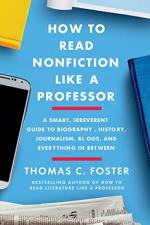
|
| Name: _________________________ | Period: ___________________ |
This test consists of 5 short answer questions, 10 short essay questions, and 1 (of 3) essay topics.
Short Answer Questions
1. According to "The Building Blocks of Arguments," what are the "grounds" of a argument?
2. In Chapter 1, "The Structure of Nonfiction Information," what are the "four Ps" that Foster discusses?
3. In Chapter 2, "The Ecology of the Nonfiction Biosphere," Foster says that rules are determined by content, not codex. What does this mean?
4. In Chapter 2, "The Ecology of the Nonfiction Biosphere," what does Foster say is the point of having a variety of media sources?
5. In Chapter 7, "All in How You Look at Things," what does Foster say beginning writers often get too caught up in?
Short Essay Questions
1. At the end of "Building Blocks of Arguments," Foster discusses mistakes in claims, grounds, and warrants. He gives the example of someone born in American Samoa claiming to be a U.S. citizen. Since American Samoa is not a territory that the U.S. recognizes as conferring birthright citizenship, Foster says that this argument is mistaken in its grounds. Is it? Explain why or why not.
2. In Chapter 6, "Source Code," what does Foster say about biographies and the length of time that has passed since the lives of their subjects?
3. In Chapter 7, "All in How You Look at Things," what are the ways that Foster suggests chronological order can be modified, and why would a writer choose to do this?
4. In Chapter 6, "Source Code," what two problems does Foster identify with the use of data as support?
5. In Chapter 1, "The Structure of Nonfiction Information," what does Foster say is the purpose of his reader being asked to think like a writer, and what is one example of how this works?
6. Why, in Chapter 2, "The Ecology of the Nonfiction Biosphere," does Foster say that it is both good and bad news that all communication has a "grammar"?
7. In Chapter 6, "Source Code," what does Foster say is the consequence of a "land without gatekeepers" (68)?
8. In Chapter 1, "The Structure of Nonfiction Information," why does Foster say that focus and telos can change if the structure of a work is changed?
9. On page 33 of "Building Blocks of Arguments," Foster compares claims and grounds to two people standing next to one another at a dance and says warrants are what "pins" them together so that they can "go steady." Explain his meaning.
10. In Chapter 8, "Bringing the News," what problem does Foster identify with creating a point of view for All the President's Men, and how do Woodward and Bernstein solve it?
Essay Topics
Write an essay for ONE of the following topics:
Essay Topic 1
Choose a piece of nonfiction--a book or longform article--and write a foreward for the work. Your foreward should offer context and key ideas that will guide readers more successfully through the work. Cite in MLA format any sources you use in creating your foreward.
Essay Topic 2
In Chapter 9, "Living the News," Foster discusses the work of Joan Didion. Write an essay in which you describe his tone in this discussion of Didion and then analyze how he creates this tone.
Essay Topic 3
In Chapter 10, "From the Inside Out," Foster explains several questions that are important to ask while reading opinions and editorials. Explain each of these questions and its importance in critical reading.
|
This section contains 1,199 words (approx. 4 pages at 300 words per page) |

|




